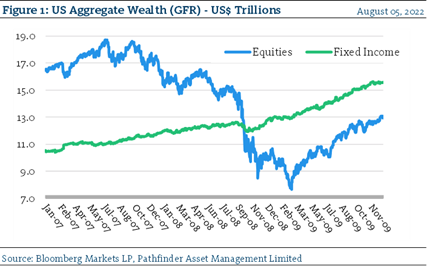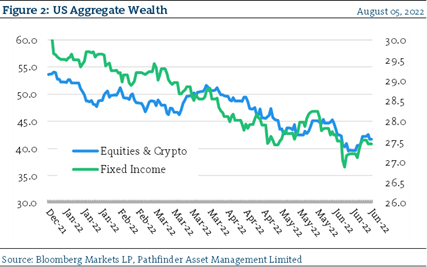The Great Balancing Effect
We began last week with a series that will explore the change in aggregate market value that has occurred since the beginning of the year. We noted that while the headlines from the financial press have captured the drop in equities and “crypto”, the change in fixed income has been somewhat less topical. We present US data, again this week, below for the first half of the year. As a reminder, the data is a compilation of various indices from FTSE Russell, Bloomberg Markets LP and CoinGeko, representing US$ 69.2 trillion in assets as of the end of June 2022. This week, we break apart the aggregate data into two groups: 1) fixed income and 2) risk assets, as represented by equities and crypto. We then isolate two periods of time so that we can study the impact of each group on total wealth.
- In Figure 1, we present data from the two-year period around the Great Financial Recession (GFR). The peak of aggregate wealth was in October of 2007 when assets were US$30T and the bottom of US$20.6T was reached in March of 2009, for a top to bottom drop of -31.4% or US$9.4T in wealth destruction.

- In Figure 2, we present the same data from the beginning of the year, although we have added Crypto assets to the equity total. We started the year at US$83.8T and ended in June at US$66.7T for US$17.0T in wealth destruction, almost twice as much as in the GFR. The difference being now that financial markets are much larger than they were in 2009, so on a percentage basis we are down –4%.
- The big take away from the two charts is how differently fixed income has behaved. With rates at generational lows coming into the beginning of the year, fixed income did not act as a balancing factor like it did during the GFR. Indeed, it has behaved more like the equity and crypto streams.

“This means that” we will still hold onto our conclusions as we progress through the study, but there is a marked difference between the behavior of financial assets between the two periods. We will broaden our study to global assets in our next issue of the series.
National Instrument 31-103 requires registered firms to disclose information that a reasonable investor would expect to know, including any material conflicts with the firm or its representatives. Doug Johnson and/or Pathfinder Asset Management Limited are an insider of companies periodically mentioned in this report. Please visit www.paml.ca for full disclosures.
*All returns are time weighted and net of investment management fees. Returns from the Pathfinder Partners’ Fund and Partners’ Real Return Plus Fund are presented based on the masters series of each fund. The Pathfinder Core: Equity Portfolio and The Pathfinder Core: High Income Portfolio are live accounts. These are actual accounts owned by the Pathfinder Chairman (Equity) and client (High Income) which contain no legacy positions, cash flows or other Pathfinder investment mandates or products. Monthly inception dates for each fund and portfolio are as follows: Pathfinder Core: Equity Portfolio (January 2011), Pathfinder Core: High Income Portfolio (October 2012) Partners’ Fund (April 2011), Partners’ Real Return Plus Fund (April, 2013), and Partners’ Core Plus Fund (November 2014).
Pathfinder Asset Management Limited (PAML) and its affiliates may collectively beneficially own in excess of 10% of one or more classes of the issued and outstanding equity securities mentioned in this newsletter. This publication is intended only to convey information. It is not to be construed as an investment guide or as an offer or solicitation of an offer to buy or sell any of the securities mentioned in it. The author has taken all usual and reasonable precautions to determine that the information contained in this publication has been obtained from sources believed to be reliable and that the procedures used to summarize and analyze such information are based on approved practices and principles in the investment industry. However, the market forces underlying investment value are subject to sudden and dramatic changes and data availability varies from one moment to the next. Consequently, neither the author nor PAML can make any warranty as to the accuracy or completeness of information, analysis or views contained in this publication or their usefulness or suitability in any particular circumstance. You should not undertake any investment or portfolio assessment or other transaction on the basis of this publication, but should first consult your portfolio manager, who can assess all relevant particulars of any proposed investment or transaction. PAML and the author accept no liability of any kind whatsoever or any damages or losses incurred by you as a result of reliance upon or use of this publication.